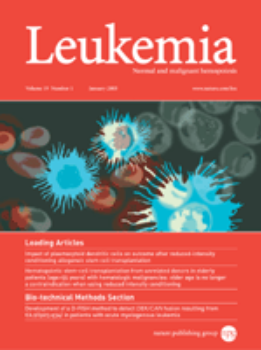同时全身多参数2-[18F]FDG-PET/MRI在阴燃型多发性骨髓瘤评估中的应用:诊断和预后影响
IF 13.4
1区 医学
Q1 HEMATOLOGY
引用次数: 0
摘要
本研究的共同主要目的是评估全身2-[18F]-氟脱氧葡萄糖-正电子发射断层扫描结合MRI (WB-2-[18F]FDG-PET/MRI)成像在阴燃多发性骨髓瘤(SMM)检查中的诊断和预后表现,以检测MM相关的髓质或髓外疾病,并预测无进展生存期(PFS), PFS定义为进展到需要治疗的症状性MM的时间。共116例SMM患者(成像前无CRAB或SLiM标准)被前瞻性纳入研究,并进行了完整的多参数WB-2-[18F]FDG-PET/MRI成像。PET在9%的患者中检测到至少一个FL >; 5 mm,而MRI为20% (p = 0.02)。PET检测到弥漫性骨髓受累(BMI)的患者占20%,MRI检测到弥漫性骨髓受累的患者占53% (p < 10−3)。对98例不需治疗的真性SMM患者进行随访。MRI上弥漫性BMI的存在是PFS最强的不良预后参数(单因素:风险比(HR), 6.12;p < 10−2;多因素:HR, 4.16;p = 0.03),可以作为进展为症状性MM的新的高风险生物标志物。基于动态对比增强(DCE)-MRI的峰值增强强度(PEI)和最大强度时间比(MITR)值的增加是其他强烈的不良预后因素。本文章由计算机程序翻译,如有差异,请以英文原文为准。
![Simultaneous whole-body multi-parametric 2-[18F]FDG-PET/MRI in smoldering multiple myeloma assessment: diagnostic and prognostic impact](https://img.booksci.cn/booksciimg/2025-8/105312031341790600974.jpg)
![Simultaneous whole-body multi-parametric 2-[18F]FDG-PET/MRI in smoldering multiple myeloma assessment: diagnostic and prognostic impact](https://img.booksci.cn/booksciimg/2025-8/2025080910069208383995.png)
Simultaneous whole-body multi-parametric 2-[18F]FDG-PET/MRI in smoldering multiple myeloma assessment: diagnostic and prognostic impact
The co-primary aims of this study were to assess the diagnostic and prognostic performance of Whole-body-2-[18F]-fluorodeoxyglucose-positron emission tomography coupled with MRI (WB-2-[18F]FDG-PET/MRI) imaging in the smoldering multiple myeloma (SMM) workup for detection of MM-related medullary or extra-medullary disease and for the prediction of progression-free survival (PFS) defined as time to progression to symptomatic MM requiring therapy. A total of 116 patients with SMM (without CRAB or SLiM criteria before imaging) were prospectively included in the study and underwent full multi-parametric WB-2-[18F]FDG-PET/MRI imaging. PET detected at least one FL > 5 mm in 9% of patients compared to 20% on MRI (p = 0.02). PET detected diffuse bone marrow involvement (BMI) in 20% of patients and MRI in 53% (p < 10−3). A total of 98 patients with true SMM not requiring treatment were then followed up. The presence of diffuse BMI on MRI was the strongest adverse prognostic parameter for PFS (univariate: hazard ratio (HR), 6.12; p < 10−2. Multivariate : HR, 4.16; p = 0.03) and could be proposed as a new high-risk biomarker for progression to symptomatic MM. Dynamic contrast-enhanced (DCE)-MRI based increased peak enhancement intensity (PEI) and maximum intensity time ratio (MITR) values were other strong adverse prognostic factors.
求助全文
通过发布文献求助,成功后即可免费获取论文全文。
去求助
来源期刊

Leukemia
医学-血液学
CiteScore
18.10
自引率
3.50%
发文量
270
审稿时长
3-6 weeks
期刊介绍:
Title: Leukemia
Journal Overview:
Publishes high-quality, peer-reviewed research
Covers all aspects of research and treatment of leukemia and allied diseases
Includes studies of normal hemopoiesis due to comparative relevance
Topics of Interest:
Oncogenes
Growth factors
Stem cells
Leukemia genomics
Cell cycle
Signal transduction
Molecular targets for therapy
And more
Content Types:
Original research articles
Reviews
Letters
Correspondence
Comments elaborating on significant advances and covering topical issues
 求助内容:
求助内容: 应助结果提醒方式:
应助结果提醒方式:


